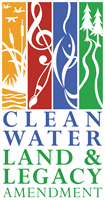Conservation easements protect natural areas
Conservation easements are one of the most effective tools for permanently protecting natural areas on private property.
A conservation easement is a set of development restrictions that a landowner voluntarily places on their property to permanently protect its natural resources. By selling or donating development rights, the landowner is able to protect thing they value about their land, whether that be the open space, views, rural character, wildlife habitat, mature forest, and more.
Learn more about conservation easements as a land protection tool from our conservation easement partner, the Minnesota Land Trust.
Funding available for land protection and restoration projects
 Hennepin County, in partnership with the Minnesota Land Trust, has received more than $4.5 million from the Lessard-Sams Outdoor Heritage Fund to acquire conservation easements on the best remaining natural areas in Hennepin County. Funding is also available for habitat restoration projects on protected properties.
Hennepin County, in partnership with the Minnesota Land Trust, has received more than $4.5 million from the Lessard-Sams Outdoor Heritage Fund to acquire conservation easements on the best remaining natural areas in Hennepin County. Funding is also available for habitat restoration projects on protected properties.
Hennepin County will evaluate potential land protection and restoration projects continuously as funds remain. Only properties that are permanently protected are eligible to receive financial assistance for land restoration.
Conservation easement establishment steps and timeline
The entire process of establishing a conservation easement typically takes 1 to 2 years starting from initial conversation and site visit.
To understand the process, see the conservation easement establishment flowchart (PDF, 1MB) and the description of each step (PDF, 1MB).
Explore natural resources on your property
The Natural Resources Interactive Map will help you explore natural resources on your property.
In the map, you can select data layers to see existing conservation easements and some land designations including ecologically significant areas and natural resources corridors.
Generally, properties that are the best candidates for protection and restoration are those near other protected property, within or adjacent to one of the land designations, and/or larger properties.
But only you know your property. Let us know what’s special about your property and your goals for its future, and we will connect you to the right resources for protection and restoration.
Contact us to learn more
Complete the interest form to get started
Complete the online land protection interest form, or contact Kristine Maurer at kristine.maurer@hennepin.us or by phone at 612-348-6570 to get started.
Next steps
Next steps after completing the form or contacting Kristine will include:
- Follow up by program staff within one week.
- A field visit to meet you, talk about your goals and motivations for your property, and walk the land.
- Advice about suitability for Hennepin County’s land protection program and potential restoration opportunities (if applicable).
- Advice and assistance related to any specific natural resource or land related questions you have.
If your property seems like a good fit for our program, we will recommend that you:
- Seek advice from your legal and tax professionals to see if land protection seems like a good possibility for your property.
- Request that you submit an application to be formally considered for protection and/or restoration through our program.